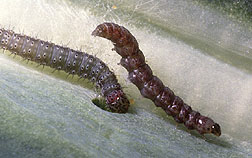Diamondback Moth Larvae

Diamondback moth larvae feed on a cabbage leaf. Photo by Doug Wilson.
Diamondback moth attacks only plants in the family Cruciferae. Virtually all cruciferous vegetable crops are eaten, including broccoli, Brussels sprouts, cabbage, Chinese cabbage, cauliflower, collard, kale, kohlrabi, mustard, radish, turnip, and watercress. Not all are equally preferred, however, and collard will usually be chosen by ovipositing moths relative to cabbage. Several cruciferous weeds are important hosts, especially early in the season before cultivated crops are available.
Plant damage is caused by larval feeding. Although the larvae are very small, they can be quite numerous, resulting in complete removal of foliar tissue except for the leaf veins. This is particularly damaging to seedlings, and may disrupt head formation in cabbage, broccoli, and cauliflower. The presence of larvae in florets can result in complete rejection of produce, even if the level of plant tissue removal is insignificant.
Diamondback moth was long considered a relatively insignificant pest. Its impact was overshadowed by such serious defoliators as imported cabbageworm, Pieris rapae (Linnaeus), and cabbage looper, Trichoplusia ni (Hubner). However, in the 1950s the general level of abundance began to increase, and by the 1970s it became troublesome to crucifers in some areas. Insecticide resistance was long suspected to be a component of the problem. This was confirmed in the 1980s as pyrethroid insecticides began to fail, and soon thereafter virtually all insecticides were ineffective. Relaxation of insecticide use, and particularly elimination of pyrethroid use, can return diamondback moth to minor pest status by favoring survival of parasitoids.
Resource: John L. Capinera, University of Florida